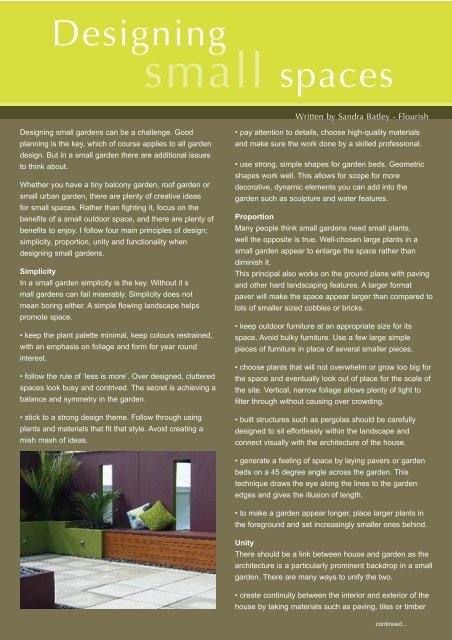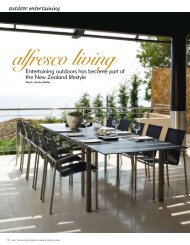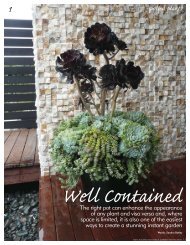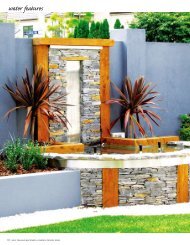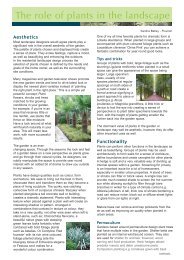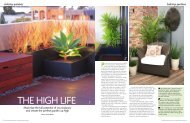small spaces
small spaces
small spaces
You also want an ePaper? Increase the reach of your titles
YUMPU automatically turns print PDFs into web optimized ePapers that Google loves.
Designing<br />
<strong>small</strong> <strong>spaces</strong><br />
Written by Sandra Batley - Flourish<br />
Designing <strong>small</strong> gardens can be a challenge. Good<br />
planning is the key, which of course applies to all garden<br />
design. But in a <strong>small</strong> garden there are additional issues<br />
to think about.<br />
Whether you have a tiny balcony garden, roof garden or<br />
<strong>small</strong> urban garden, there are plenty of creative ideas<br />
for <strong>small</strong> <strong>spaces</strong>. Rather than fighting it, focus on the<br />
benefits of a <strong>small</strong> outdoor space, and there are plenty of<br />
benefits to enjoy. I follow four main principles of design;<br />
simplicity, proportion, unity and functionality when<br />
designing <strong>small</strong> gardens.<br />
Simplicity<br />
In a <strong>small</strong> garden simplicity is the key. Without it s<br />
mall gardens can fail miserably. Simplicity does not<br />
mean boring either. A simple flowing landscape helps<br />
promote space.<br />
• keep the plant palette minimal, keep colours restrained,<br />
with an emphasis on foliage and form for year round<br />
interest.<br />
• follow the rule of ‘less is more’. Over designed, cluttered<br />
<strong>spaces</strong> look busy and contrived. The secret is achieving a<br />
balance and symmetry in the garden.<br />
• stick to a strong design theme. Follow through using<br />
plants and materials that fit that style. Avoid creating a<br />
mish mash of ideas.<br />
• pay attention to details, choose high-quality materials<br />
and make sure the work done by a skilled professional.<br />
• use strong, simple shapes for garden beds. Geometric<br />
shapes work well. This allows for scope for more<br />
decorative, dynamic elements you can add into the<br />
garden such as sculpture and water features.<br />
Proportion<br />
Many people think <strong>small</strong> gardens need <strong>small</strong> plants,<br />
well the opposite is true. Well-chosen large plants in a<br />
<strong>small</strong> garden appear to enlarge the space rather than<br />
diminish it.<br />
This principal also works on the ground plane with paving<br />
and other hard landscaping features. A larger format<br />
paver will make the space appear larger than compared to<br />
lots of <strong>small</strong>er sized cobbles or bricks.<br />
• keep outdoor furniture at an appropriate size for its<br />
space. Avoid bulky furniture. Use a few large simple<br />
pieces of furniture in place of several <strong>small</strong>er pieces.<br />
• choose plants that will not overwhelm or grow too big for<br />
the space and eventually look out of place for the scale of<br />
the site. Vertical, narrow foliage allows plenty of light to<br />
filter through without causing over crowding.<br />
• built structures such as pergolas should be carefully<br />
designed to sit effortlessly within the landscape and<br />
connect visually with the architecture of the house.<br />
• generate a feeling of space by laying pavers or garden<br />
beds on a 45 degree angle across the garden. This<br />
technique draws the eye along the lines to the garden<br />
edges and gives the illusion of length.<br />
• to make a garden appear longer, place larger plants in<br />
the foreground and set increasingly <strong>small</strong>er ones behind.<br />
Unity<br />
There should be a link between house and garden as the<br />
architecture is a particularly prominent backdrop in a <strong>small</strong><br />
garden. There are many ways to unify the two.<br />
• create continuity between the interior and exterior of the<br />
house by taking materials such as paving, tiles or timber<br />
continued...
from the inside out into the garden. This idea works<br />
particularly well if you have a courtyard or patio<br />
immediately off the kitchen or living area.<br />
• visually link the interior with the outdoors by<br />
introducing colour used in furnishings with foliage or<br />
flowers planted in the garden.<br />
• unify the planting in a <strong>small</strong> space by repeating<br />
groups of plants or keep to a single colour theme.<br />
• take a look at the external architecture of the house<br />
and repeat some of these basic shapes in the garden.<br />
• most <strong>small</strong> gardens are viewed from the house, so<br />
think about creating visual focal points viewed from<br />
within the house. Whether it’s a plant or a gorgeous<br />
piece of sculpture.<br />
Functionality<br />
Form follows function in a <strong>small</strong> space. In tiny gardens,<br />
where space is limited, every inch of it must be used to<br />
advantage. It needs to provide a useful function as well<br />
as look aesthetically pleasing.<br />
• use elements that have a dual purpose, such as<br />
planters that double as seating. Or create storage<br />
inside a closed timber bench seat.<br />
• include plenty of seating. Make sure paving or<br />
decking areas are big enough to include a table and<br />
chairs. Bench seating is the best way to deal with tight<br />
areas. They tend to sit on the perimeter of paving so it<br />
does not intrude too much.<br />
• some amazing dramatic effects can be created using<br />
lighting. By adding lighting you can utilize the garden<br />
after dark. Avoid putting too much light onto<br />
boundaries. Feature trees, water features and gazebos<br />
will benefit from subtle lighting.<br />
By following some of these simple rules, your garden<br />
will feel comfortable, not cramped. You’ll have an<br />
intimate space that suits all your needs.<br />
Sandra is landscape designer based in Auckland.


